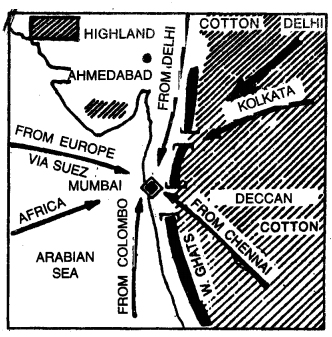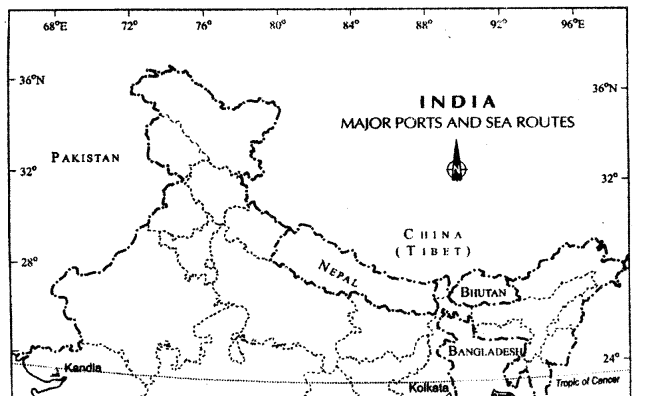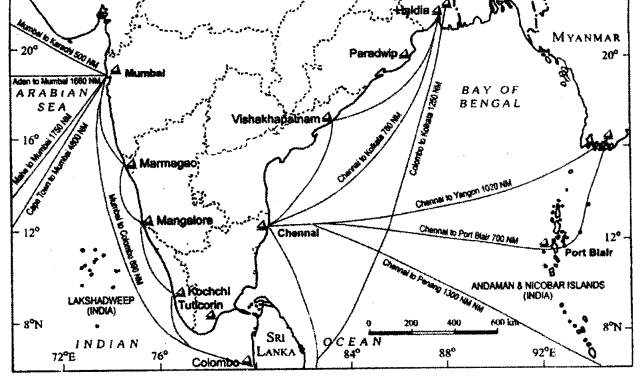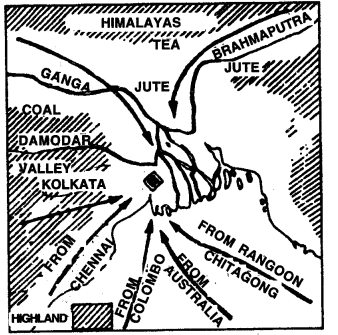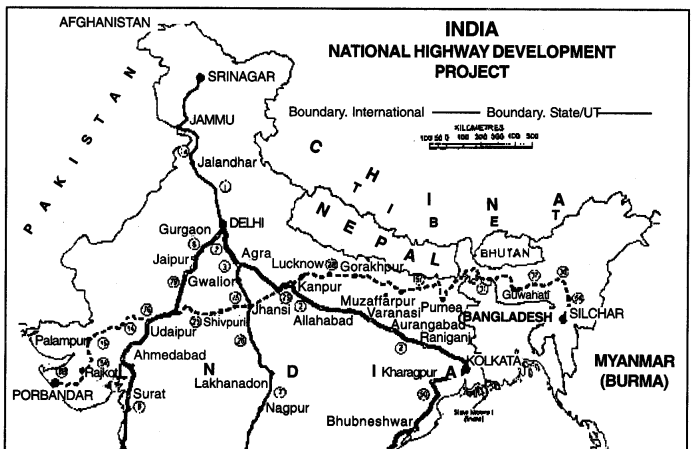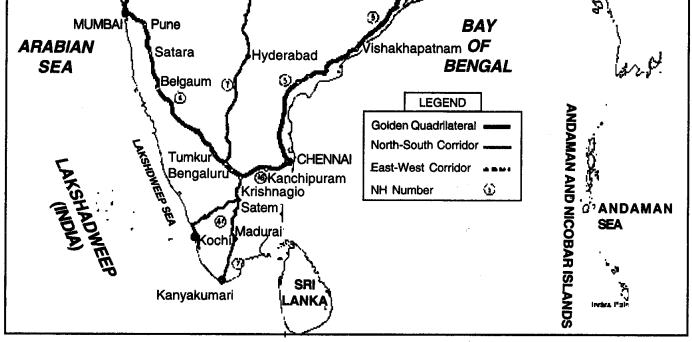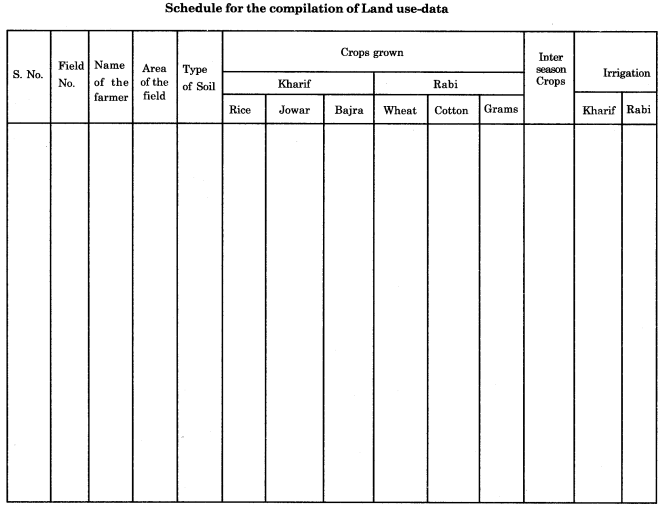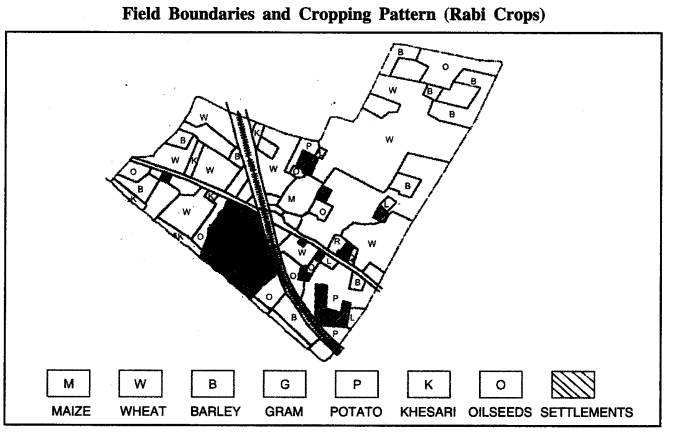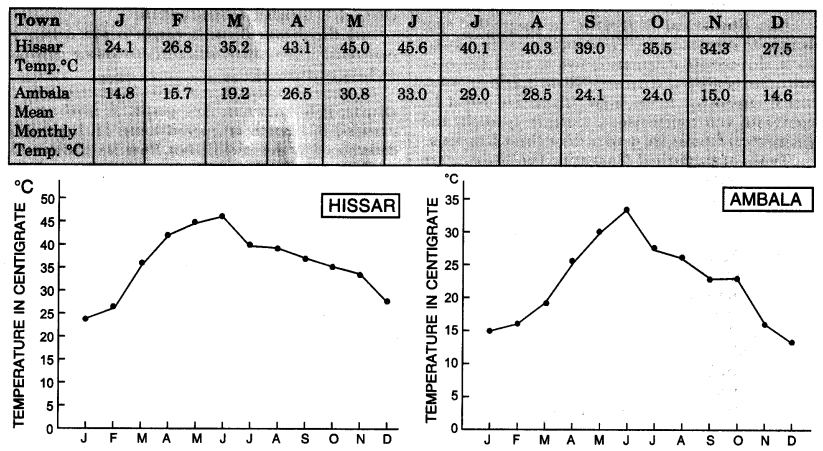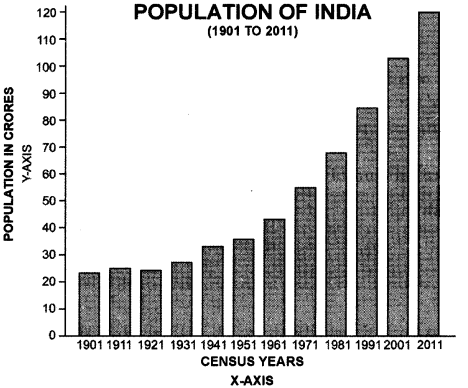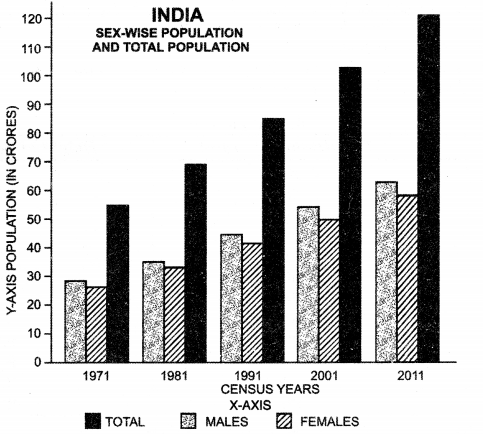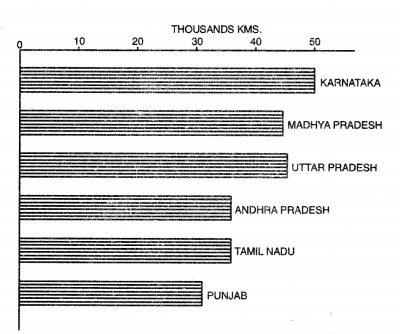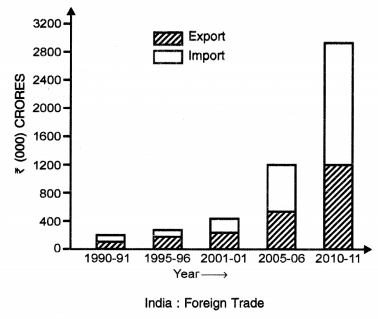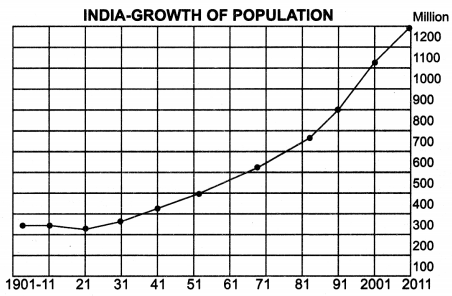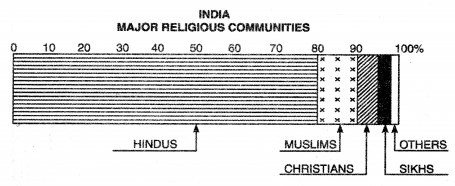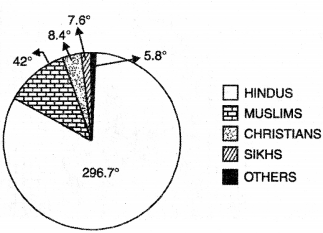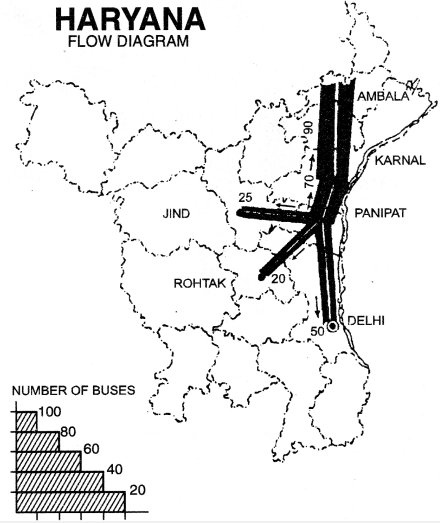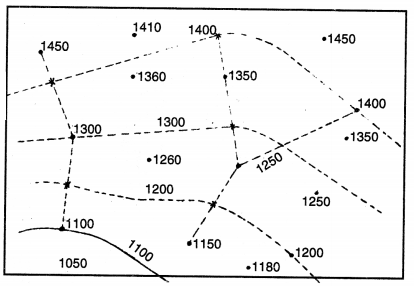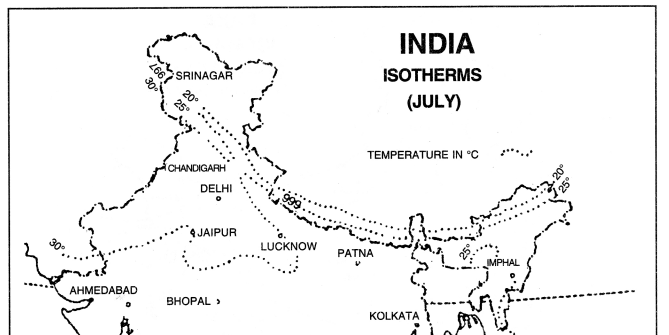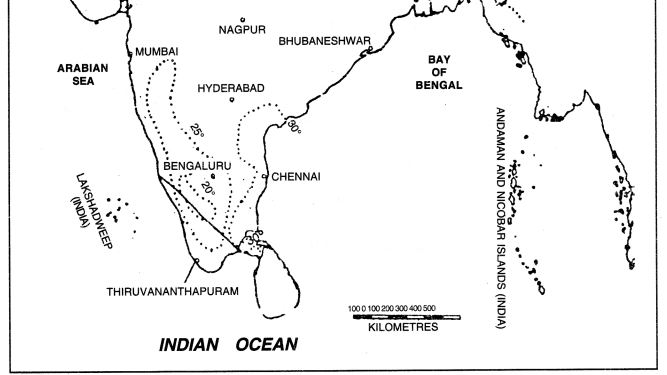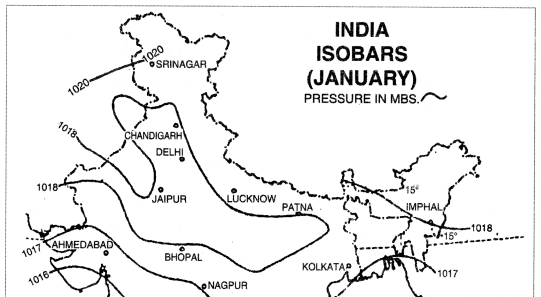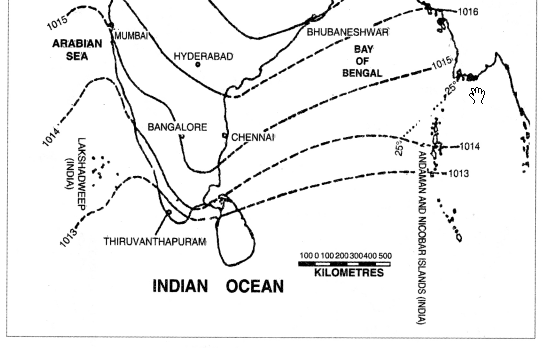Here we are providing Class 12 Geography Important Extra Questions and Answers Chapter 5 Land Resources and Agriculture. Geography Class 12 Important Questions are the best resource for students which helps in class 12 board exams.
Class 12 Geography Chapter 5 Important Extra Questions Land Resources and Agriculture
Land Resources and Agriculture Important Extra Questions Very Short Answer Type
Question 1.
How much part of total geographical area is cultivated ?
Answer:
43%.
Question 2.
What is the percentage of fallow land ?
Answer:
7.6%.
Question 3.
What is the average crop intensity in India ?
Answer:
130%.
Question 4.
What is total production of food grains in India ?
Answer:
2500 Lakh tonnes (2012).
Question 5.
What is the total production of Rice in India ?
Answer:
1020 Lakh tonnes (2012).
Question 6.
What is total production of Wheat in India ?
Answer:
840 Lakh tonnes (2012).
Question 7.
What is the total production of Tea in India ?
Answer:
10 Lakh tonnes.
Question 8.
How much percent of population depends on agriculture for its livelihood ?
Answer:
70 percent.
Question 9.
What is fallow land ?
Answer:
A land which is not cultivated for 1 to 5 years.
Question 10.
Which state has the highest intensity of crops ?
Answer:
Punjab, 189 percent.
Question 11.
State the formula to calculate cropping intensity. (C.B.S.E. 2009)
Answer:
\(=\frac{\text { Gross Cultivated Area }}{\text { Net Sown Area }} \times 100\)
Question 12.
Name the main cropping seasons of India.
Answer:
Kharif, Rabi and Zaid.
Question 13.
Name the three crops of Rice grown in one year.
Answer:
Aus, Aman and Boro.
Question 14.
Name the main types of Oil seeds grown in India.
Answer:
Groundnut, rapeseed, mustard, soyabean and sunflower.
Question 15.
How much area is irrigated in India ?
Answer:
570 lakh hectares.
Question 16.
Name the two most important cereal crops of India. Give the name of any two states which are the important producers of each of their crops.
Answer:
Wheat and Rice are the two most important cereal crops of India.
Important Producers
(a) Wheat: Uttar Pradesh and Punjab
(b) Rice: Uttar Pradesh and Punjab.
Question 17.
Explain any three features of dryland farming in India. (C.B.S.E. 2013)
Answer:
(i) Dryland farming is practised in areas with less than 75 ems rainfall.
(ii) This type of farming grows hard and resistant crops.
(iii) This practices method of soil moisture conservation.
Question 18.
Name the leading state in the production of Jute in India. (C.B.S.E. 2014)
Answer:
West Bengal.
Land Resources and Agriculture Important Extra Questions Short Answer Type
Question 1.
Distinguish between reporting area and geographical area.
Answer:
The land use categories add up to reporting area, which is some what different from the geographical area. The Survey of India is responsible for measuring geographical area of administrative units in India. The reporting area is calculated on land revenue records. The difference between the two concepts is that while the former changes somewhat depending on the estimates of the land revenue records, the latter does not change.
Question 2.
Distinguish between actual forest cover and classified forests.
Answer:
Actual forest cover is different from area classified as forest. The classified forest area is identified and demarcated by government for forest growth. But the actual forest cover is that area where forests are actually found.
Question 3.
State three facts to show the Agricultural development in India.
Answer:
Agriculture continues to be an important sector of Indian eocnomy,
(i) In 2001, about 53 per cent population of the country was dependent on it.
(ii) The importance of agricultural sector in India can be gauged from the fact that about 57 per cen t of its land is devoted to crop cultivation, whereas, in the world, the corresponding share is only about 12 per cent.
(iii) In spite of this, there is tremendous pressure on agricultural land in India, which is reflected from the fact that the land-human ratio in the country is only 0.31 ha. which is almost half of that of the world as a whole (0.59 ha.).
Question 4.
Define Agriculture. Which conditions favour agriculture ?
Answer:
Agriculture is the art and science of cultivating the land, raising crops for food. It includes tilling of land, raising of crops, and cattle rearing. The term agriculture has been derived from two Latin words: ager meaning ‘land’ and cultura meaning ‘cultivation’. Agriculture thus means cultivation of
land and tending of animals.
Favourable conditions for Agriculture : All lands are not suitable for cultivation.
Physical conditions : For crop raising land must be level, covered with fertile soils and have adequate rainfall and favourable temperature.
Human conditions : How man uses land also depends on the technology, tenure and size of the holdings, government policies and several other infrastructural factors.
Question 5.
What is the net sown area in India ? Where does India rank in world ?
Answer:
Land utilization statistics are available for 92.8 per cent of total geographical area (328.73 million hectares) of India. The net sown area is 140.3 million ha. in 2011-2012; it increased to 142.82 million ha. in 1996-97. Thus, about 46.59 per cent of the geographical area of the country is currently under cultivation as against only 36.1 per cent in 1950-51. About 23.2 million hectares are classified as fallow lands which constitute 7.6 per cent of the reported area.
Thus, India has more than half of the total area under cultivation. It is pertinent to note that India stands seventh in the world in terms of total geographical area but second in terms of cultivated land. The first being the LTnited States of America, which is two and a half times larger than India in land area.
Question 6.
Describe three main achievements of the Green Revolution in India.
Answer:
(i) It has led to a substantial increase in production and productivity of foodgrains increasing from 72 million tonnes (1965-66) to 210 million tonnes (2003-04).
(ii) Import of foodgrains declined from 10.3 million tonnes (1965-66) to 2.4 million tonnes in 1983-84. There was no import of food grains in 2000-01.
(iii) The croppd area, use of high yielding varities, the yield per hectare use of irrigation and fertilisers has increased.
Question 7.
Why is agricultural productivity still low in India ? Write three main reasons.
Answer:
In India, the yield per hectare of foodgrains and other crops is low. The main reasons lare:
(i) Less use of HYV. Only 16% of the cultivated land is under HYV.
(ii) Poor technique. The fertility of soils is declining. Use of fertilisers and pesticides is limited.
(iii) Low investment. Poor farmers cannot invest in agriculture. Size of farms is small.
Question 8.
Describe any three haraeteristies of wetland farming in India. (2013)
Answer:
(i) In wetland farming, rainfall is more than 75 cms.
(ii) These grow various water intensive crops such as Rice, Jute, etc.
(iii) Rainfall is in excess of soil moisture requirements of plants.
Question 9.
Classify land according to its ownership. State the characteristics of common property sources. Why are common property resource called natural resources ?
Answer:
Land, according to its ownership can broadly be classified under two broad heads—
(i) private land and
(ii) common property resources (CPRs). While the former is owned by an individual or a group of individuals, the latter is owned by the state meant for the use of the community. CPRs provide fodder for the livestock and fuel for the households along with other minor forest products like fruits, nuts, fibre, medicinal plants, etc.
In rural areas, such land is of particular relevance for the livelihood of the landless and marginal farmers and other weaker sections since many of them depend on income from their livestock due to the fact that they have limited access to land. CPRs also are important for women as most of the fodder and fuel collection is done by them in rural areas. They have to devote long hours in collecting fuel and fodder from a degraded area of CPR.
Natural Resources. CPRs can be defined as community’s natural resource, where every member has the right of access and usage with specified obligations, without anybody having property rights over them. Community forests, pasture lands, village water bodies and other public spaces where a group larger than a household or family unit exercises rights of use and carries responsibility of management are examples of CPRs.
Question 10.
What is the importance of land resources ? State three facts.
Answer:
Land resource is more crucial to the livelihood of the people depending on agriculture :
(i) Agriculture is a purely land based activity unlike secondary and tertiary activities. In other words, contribution of land in agricultural output is more compared to its contribution in the outputs in the other sectors. Thus, lack of access to land is directly correlated with incidence of poverty in rural areas.
(ii) Quality of land has a direct bearing on the productivity of agriculture, which is not true for other activities.
(iii) In rural areas, aside from its value as a productive factor, land ownership has a social value and serves as a security for credit, natural hazards or life contingencies, and also adds to the social status.
Question 11.
‘Scope for bringing in additional land under net sown area in India is limited.’ Discuss. How can we increase cultivated land ?
Answer:
It may be observed that over the years, there has been a marginal decline in the available total stock of cultivable land as a percentage to total reporting area. There has been a greater decline of cultivated land, in spite of a corresponding decline of cultivable wasteland. It is clear that the scope for bringing in additional land under net sown area in India is limited.
There is, thus an urgent need to evolve and adopt land-saving technologies. Such technologies can be classified under two heads—those which raise the yield of any particular crop per unit area of land and those which increase the total output per unit area of land from all crops grown over one agricultural year by increasing land-use intensity.
The advantage of the latter kind of technology is that along with increasing output from limited land, it also increases the demand for labour significantly. For a land scarce but labour abundant country like India, a high cropping intensity is desirable not only for fuller utilisation of land resource, but also for reducing unemployment in the rural economy.
Question 12.
Describe the different cropping seasons in India. Name the crops grown in each season. (C.B.S.E. 2014)
Answer:
Cropping Seasons in India
There are three distinct crop seasons in the northern and interior parts of country, namely kharif, rabi and zaid.
(1) The kharif season largely coincides with Southwest Monsoon under which the cultivation of tropical crops such as rice, cotton, jute, jowar, bajra and tur is possible.
(2) The rabi season begins with the onset of winter in October-November and ends in March-April. The low temperature conditions during this season facilitate the cultivation of temperate and subtropical crops such as wheat, gram and mustard.
(3) Zaid is a short duration summer cropping season beginning after harvesting of rabi crops. The cultivation of watermelons, cucumbers, vegetables and fodder crops during this season is done on irrigated lands.
Question 13.
Distinguish between wetland farming and dryland farming.
Answer:
Rainfed farming is further classified on the basis of adequacy of soil moisture during cropping season into dryland and wetland farming. In India, the dryland farming is largely confined to the regions having annual rainfall less than 75 cm. These regions grow hardy and drought resistant crops such as ragi, bajra, moong, gram and guar (fodder crops) and practise various measures of soil moisture conservation and rain water harvesting.
In wetland farming, the rainfall is in excess of soil moisture requirement of plants during rainy season. Such regions may face flood and soil erosion hazards. These areas grow various water intensive crops such as rice, jute and sugarcane and practise aquaculture in the fresh water bodies.
Question 14.
Distinguish between Protective irrigated farming and Productive irrigated farming.
Or
Distinguish between Protective Irrigation and Productive Irrigation. (Outside Delhi 2019)
Answer:
On the basis of main source of moisture for crops, the farming can be classified as irrigated and rainfed (barani). There is difference in the nature of irrigated farming as well based on objective of irrigation, i.e. protective or productive. The objective of protective irrigation is to protect the crops from adverse effects of soil moisture deficiency which often means that irrigation acts as a supplementary source of water over and above the rainfall.
The strategy of this kind of irrigation is to provide soil moisture to maximum possible area. Productive irrigation is meant to provide sufficient soil moisture in the cropping season to achieve high productivity. In such irrigation the water input per unit area of cultivated land is higher than protective irrigation.
Question 15.
Name the major oil seeds grown in India. Also state the major areas of production.
Answer:
The oilseeds are produced for extracting edible oils. Drylands of Malwa plateau, Marathwada, Gujarat, Rajasthan, Telangana and Rayalseema region of Andhra Pradesh and Karnataka plateau are oilseeds growing regions of India. These crops together occupy about 14 per cent of total cropped area in the country. Groundnut, rapeseed and mustard, soyabean and sunflower are the main oilseed crops grown in India.
Question 16.
(i) What is intensity of cropping ?
(ii) Explain four factors affecting it.
(iii) Give two reasons for high index of intensity of cropping in Punjab.
Answer:
Intensity of cropping means the number of crops raised on the same field in one agricultural year. If two crops are grown in a year, the index of cropping is 200. It shows intensive use of the land. Intensity of cropping is influenced by the following factors:
- Irrigation facilities
- Use of fertilisers
- Use of high yielding varieties
- Mechanisation
- Use of pesticides.
The intensity of cropping in Punjab is due to high inputs. There is heavy application of fertilisers. A large area is under irrigation and mechanised farming. High yielding varieties are grown.
Question 17.
Distinguish between crop rotation, crop intensity and mixed cropping.
Answer:
Crop rotation means the cultivation of different crops in the same field year after year. The change of crops helps to maintain the fertility of the fields. Crop intensity means the number of crops grown on the same field in the agricultural year. Mixed cropping refers to the practice of sowing two to three crops together in the same field in one crop season.
Question 18.
What does the term dry farming mean ?
Answer:
Dry farming is an agricultural method practised in areas where rainfall is scanty (less than 50 cms). In such regions, irrigation facilities are also not available. In this method, deep ploughing is done after every rain to preserve most of the rain water. In such areas, one crop is grown in a year. Generally, drought resisting crops like wheat, cotton, gram and pulses are grown. In India, dry farming is practised in arid areas of Rajasthan, Gujarat and Haryana.
Question 19.
What do you mean by fallow land ? How can we reduce the period of fallowing ?
Answer:
Continuous cropping in the same field for a long period results in the depletion of soil-nutrients. In order to provide time for the recoupment of the soil fertility, land is kept without crop for a season or a year. The soil fertility increases through this natural process. When land is left without crop for a season it is called current fallow land. It is called old fallow land if it is left without crop for a period of more than one year. The extent of fallowing may be reduced by higher dose of fertilizer and manure.
Question 20.
Which are the two important staple food crops of India ? Give three points of contrast in the climatic and soil requirements of the two crops named by you.
Answer:
Wheat and rice are the two staple crops. Wheat needs cool wet growing season and warm dry harvesting season, but rice needs high temperature throughout. Wheat needs moderate rainfall. Rice needs high rainfall. Loamy soils are best suited for wheat, while rice is grown on alluvial soils.
Question 21.
Describe lancUuse pattern in ndia. C.B.S.E. 2011)
Answer:
Land-use pattern. Land is a limited resource. Attempts are made to make the maximum use of land. India has a total geographical area of 32.8 crore hectares. Main characteristics of land-use are as under:
(a) Net Sown area. About 54% of total land (7.6 crore hectares) is net sown area. This vast area shows the importance of agriculture in India.
(b) Fallow land. About 7% land (2.4 crore hectares) is left as fallow land and is cultivated after two or three years.
(c) Forests. About 23% of land is (6.6 crore hectares) under forests.
(d) Plantation crops. About 1% land is under plantation crops like tea, coffee, etc.
(e) Other uses. Land under permanent grassland, cultivable waste and not available for cultivation amounts to about 5 crore hectares. Area under forests is increasing. Fallow land has been reduced in area. Net sown area under doubled cropped area is also increasing.
Question 22.
What is crop rotation ? Why has this method been adopted ?
Answer:
When the different crops are sown turn by turn in the same field; it is called crop rotation. For example: Pulses, Legumes and Oilseeds are grown in the same field after harvesting food crops. This is helpful in correcting the imbalance of the soil nutrients.
Same crop year after year accelerates the loss of soil nutrients. Legumes have the utility of fixing nitrogen of the soil from atmosphere. Oilseeds also fix nitrogen. Highly fertilizer intensive crops like sugarcane or tobacco are rotated with cereal crops. Selection of the crops for rotation depends upon the local soil conditions and the experience of the farmers.
Question 23.
Explain the importance of agriculture in Indian economy.
Answer:
India is an agricultural country. Agriculture is not only the backbone of Indian economy, but also a way of living in India. Agriculture provides work to about 70 per cent of the total work force of the country. It contributes 35 per cent of the net national product. It provides food for hillions of people of the country. About 20 crore herds of cattle get fodder.
Agriculture provides raw materials to agro-based industries like cotton textiles, sugarcane, etc. It also contributes a sizeable share of the country, total exports—by earning a foreign exchange of about ? 5000 crores which accounts for about 70% on total exports. Agriculture provides base for development of other sectors. It ensures higher purchasing power in rural areas. It generates demand for industrial goods.
Question 24.
How did Green Revolution bring about ‘grain revolution’ in some parts of India ?
Answer:
Since the 1960s, a new strategy has been used for the intensive agricultural development in India. It has led to a rapid increase in the production of foodgrains in the country. A revolution has taken place in the agricultural methods and technology. This revolution is known as Green Revolution. It includes the use of better quality seeds, high yielding varieties, chemical fertilisers, agricultural machinery and to provide irrigation facilities. It has led to a complete modernisation of Indian agriculture.
This strategy was introduced to do away with food shortage and import of foodgrains. In 1965, the total production of foodgrains was 90 million tonnes. It became essential to increase the cropped area total production and yield per hectare. Wonderful results were achieved through Green Revolution. The total production of foodgrains in 2015-2016 has increased to above 280 million tonnes. In fact, Green Revolution has been a grain revolution.
It is clear from the following table :
| Year | Foodgrains production (Million tonnes) |
| 1970 – 71 | 108.4 |
| 1980 – 81 | 129.6 |
| 1990 – 91 | 176.4 |
| 2000 – 01 | 196.8 |
| 2006 – 07 | 217.3 |
| 2009 – 10 | 218.1 |
| 2015 – 16 | 280.0 |
The adoption of Green Revolution has given a boost to agricultural development in many aspects such as:
(i) The chopped area has increased due to multiple cropping.
(ii) The use of high yielding varieties of wheat and rice like Kalyan, S-308, Jaya, Ratna, etc. have led to increased yields per hectare. The yield of wheat rose from 13 quintal per hectare to 33 quintals per hectare in Punjab. In case of rice, a 45% increase in productivity was obtained in Andhra Pradesh.
(iii) The use of extensive irrigation increased the total production of foodgrains.
(iv) Use of chemical fertilisers led to higher yield per hectare.
(v) Massive programme of farm mechanisation, use of better quality seeds and pesticides, use of agricultural implements has led to the success of Green Revolution.
Question 25.
Review any five measures adopted to solve the problems of Indian agriculture.
Answer:
Agriculture is a very important sector of Indian economy. In spite of the phenomenal progress particularly since the 1960s, Indian agriculture still suffers from several serious problems, such as :
(1) Dependence on Erratic Monsoon : Unfortunately, most parts of the India receive rainfall in 3 – 4 months of the rainy season and rest of the year is practically dry, large (parts) of the country do not receive sufficient amount of rainfall. Such areas can give high agricultural productivity if sufficient arrangements for irrigation and water harvesting are made.
(2) Low Productivity : Yields of almost all the crops in India is very low. High pressure of population results in low labour productivity. We have to use HYV seeds and fertilizes to increase the productivity.
(3) Small Farm Size: Small land holdings is major obstacle in the way of modernisation of agriculture. These are some states where consolidation of holding has not yet been carried out even once.
(4) Lack of Commercialisation : Indian agriculture is still of subsistence type. Foodgrains produced by small and marginal farmers are just sufficient to meet the requirement of the family members of the farmers. Irrigation and modern farm techniques has spread to the country at a rapid pace.
(5) Lack of development of rural infrastructure, withdrawal of subsidies and price support and crop rotation etc., reduce the regional imbalances if these implement properly.
Land Resources and Agriculture Important Extra Questions Long Answer Type
Question 1.
Discuss the geographical conditions favouring the cultivation of wheat. Describe production and areas of cultivation in India.
Answer:
Wheat is one of the master grains of the world. It is the ‘staple food’ for 1/3 people of the world. It is a valuable cereal due to high gluten content. It has been grown since pre-historic times. It was originally grown in Mediterranean lands.
Conditions of Growth. Wheat is a plant of temperate latitudes. It is grown in a variety of climates. The cultivation of wheat is widespread in the world. Every month, wheat is being seeded or being harvested in some part of the world.
(i) Temperature. Wheat requires a minimum temperature of 10°C in the growing period and a maximum temperature of 20°C in the harvesting period. A frost-free period of 100 days is required for wheat.
(ii) Rainfall. The wheat lands generally need a moderate rainfall between 50 to 100 cms. annually. Wheat needs a cool and wet growing season, but a warm and a dry harvesting season.
(iii) Irrigation. Means of irrigation are used in areas of low rainfall as in Indus and Punjab. Dry farming methods are also used.
(iv) Soil. Light clay or heavy loamy soil is the best soil for wheat.
(v) Land. Wheat needs well-drained level land. It suits the use of machinery and means of irrigation.
(vi) Economic Factors: Wheat is a soil exhausting crop. Better seeds, chemical fertilisers and new varieties are used to increase the yield per hectare. It is a mechanised agriculture.Machines like tractors, combines, harvesters are often used. Huge stores are required to store wheat.
Production in India: India ranks as the second largest producer of wheat in the world (12% production). Wheat is a winter crop and India produces about 67 million metric tons of wheat. India has become self-sufficient in wheat production due to Green Revolution, yield per hectare is 2618 kg.
Area of cultivation: Wheat is grown in most of the Sutlej-Ganga plain (N.W. India). Spring wheat is grown in hilly areas of Lahaul-Spiti (Himachal Pradesh), Ladakh, Sikkim in the Sub-Himalayan region, upto a height of 2700 metres. Wheat is grown on 14% of Net Sown area. Uttar Pradesh, Punjab, Haryana, Madhya Pradesh and Rajasthan are the main wheat producing areas. These regions have the favourable conditions of fertile soils, winter rain, irrigation facilities.
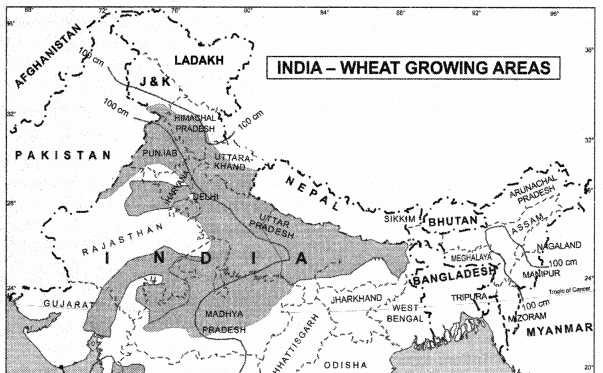
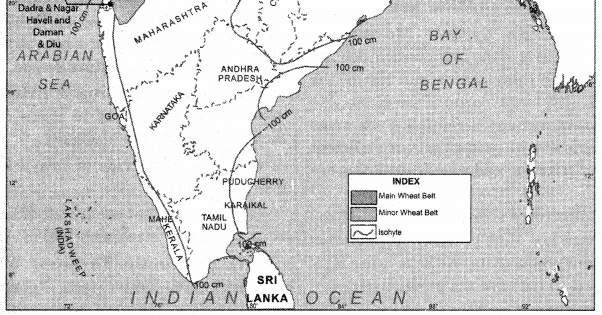
Question 2.
Describe the conditions of growth, production and major area of cultivation of rice in India.
Answer:
Rice had been cultivated since pre-historic times. China and India are regarded as the birthplace of rice. Rice is the staple food of millions of people in monsoon Asia. Rice is also called ‘Gift of Asia’.
Types of rice:
There are many varieties of rice but rice is broadly divided into two types
(i) Upland Rice. This rice is grown in hilly areas and has low yields.
(ii) Lowland Rice. This rice is grown on the lowland areas of river valleys and deltas and has high yields.
Methods of cultivation:
Rice is sown by three methods:
(i) Drilling method
(ii) Broadcasting method.
(iii) Transplanting method.
Conditions of growth:
Rice is a crop of hot-wetland of the tropics. Rice cultivation is concentrated in Monsoon Asia.
(i) Temperature. Rice needs a temperature of 20°C during the growing season and a temperature of 27°C during the harvesting period. Due to uniformly high temperature, 3 crops of rice a year are produced in West Bengal.
(ii) Rainfall. Rice is a plant of wet areas with an annual rainfall between 100 to 200 cms. Rice is grown in flooded fields. Irrigation is used in areas of low rainfall as in Punjab.
(iii) Land. Rice needs level land so that the fields can be flooded. Rice is grown on hilly slopes with Terraced Agriculture upto a height of 2000 metres.
(iv) Soils. Heavy clay or loamy soil is the ideal soil for rice. River valleys, delta and coastal plains are most suited for rice cultivation.
(v) Cheap Labour. Rice needs large supply of cheap human labour. It is labour intensive crop because most of the work in the fields is done by hand. It is also called ‘Hoe-culture’. The densely populated areas supply cheap plentiful labour.
In brief we can say ‘Rice needs plenty of heat, plenty of water, plenty of alluvium, plenty of labour to produce plenty of rice for plenty of people. ’
India. India is the second largest producer of rice in the world. About 24% (22%) of the (40 million hect.) cultivated land is under rice. India produces about 86 million metric tons of rice. Over large areas, only one crop of rice is grown every year. The yield per hectare is not high. High-yielding varieties are being used to increase the production. Yield per hectare is 1562 kg.
West Bengal is the largest producer of rice in India. Due to hot and wet climate, 3 crops are grown on the same land in a year. Aman, Aus and Boro are the three types of rice crops. Rice is grown throughout the Sutlej-Ganges plain in Punjab, Haryana (with irrigation), Uttar Pradesh and Bihar and coastal plains.
Question 3.
Describe the conditions of growth, production, areas of cultivation of cotton in India.
Answer:
Cotton is the leading fibre crop of the world. Of all the fibres, cotton is produced in the largest quantity. It is known from the writing of Herodotus that cotton has been in use in India since 3000 BCE. It is a universal fibre. Now-a-days many synthetic fibres are being used, but the cheapness and lightness of cotton make it an ideal fibre for clothing.
Conditions of Growth. Cotton is a plant of tropical and subtropical areas.
(i) Temperature. Cotton needs uniformly high summer temperatures between 22°C to 32°C. It requires a warm climate with bright sunshine. Frost is harmful to cotton plant. A growing period of 210 frost free days is necessary. It is grown as an annual crop. Sea breezes increase the lustre and length of the cotton fibre.
(ii) Rainfall. Cotton needs light to moderate rainfall between 50 to 100 cms. It needs light showers during the growing period and a dry sunny picking period.
(iii) Irrigation. In arid areas, irrigation is used. It increases the yield per hectare as in Punjab.
(iv) Soils. Cotton grows best on rich,well-drained loamy soils. Lava soil is capable of retaining moisture and is highly suitable for the cultivation of cotton. Regular use of fertilisers is required to maintain the fertility of the soil.
(v) Cheap Labour. Cotton is picked by hand. Generally women labour is used. The presence of large, cheap and hard-working labour is necessary.
(vi) Land. Cotton is grown best on flat, or rolling lands. These are well-drained areas. Machinery can be used in such areas.
(vii) Absence of Diseases. The control of pests and diseases is necessary.
India. India is the fourth largest producer (8.3%) of cotton in the world. India has the largest acreage under cotton cultivation. India is the oldest cotton- producing country in the world. The Cotton Textile Industry depends on Indian cotton. India has low yield of cotton.
Mostly short staple cotton is produced. Long staple cotton is imported from Egypt, Sudan and Pakistan. About 65 lakh hectare area (4.7% area) is under cotton cultivation. The total production is 20 lakh tonnes.
Areas of Cultivation. Due to a great diversity in climate and soil the cotton producing areas are found scattered over India. Southern India produces more cotton than Northern India.
(i) Black Cotton Soil Region. This is chief cotton growing area of India on the lava soils of North-West Deccan. Gujarat, Maharashtra and Madhya Pradesh are the major cotton-producing states.
(ii) Red Soil Region. Medium staple cotton is grown in the red soil area including the states of Tamilnadu, Karnataka and Andhra Pradesh.
(iii) Alluvial Soil Region. Long staple cotton (Narma) is grown on the Alluvial soils of Northern plain. The states of Punjab, Haryana and Rajasthan are the important producers of cotton. Punjab has the highest yield per hectare due to wrarm climate, fertile soil and facilities of irrigation.
Question 4.
Describe the geographical conditions required for the cultivation of Tea. Describe its production and distribution in India.
Answer:
Tea is the most popular and stimulating drink in the world. Assam (India) and China are the native places of tea. Tea plantations were started by the Europeans. Tea is made from the leaves of a tropical bush. It contains a stimulating substance called Theme’or ‘Tannic acid.’
Types of Tea. Different varieties of Tea fall into four main types:
- Black Tea.
- Green Tea.
- Brick Tea.
- Oolong Tea.
Conditions of Growth. Tea is a plant of both tropical and temperate areas.
(i) Temperature. Tea requires uniformly high temperature (20°C – 30°C) throughout the year. More pickings can be done due to warm summers. Frost is harmful for tea leaves.
(ii) Rainfall. An annual rainfall of 150 cms. is essential for the growth of tea. Rainfall should be uniform and in frequent showers. Long-dry season is harmful for tea. Shady trees protect tea-bushes from strong sunlight. Irrigation is also used.
(iii) Soil. Tea requires a deep and fertile soil. Soil should be acidic to give better flavour. A content of iron and potash is helpful.
(iv) Land. Tea is grown on gently sloping, well- drained hilly slopes and valley-sides. Tea plantations are most suited upto a height of 300 metres above sea level.
(v) Labour. Tea is a labour intensive crop. It requires a cheap, skilled labour for picking tea leaves. Picking is done by hand. Mostly women labour is used for picking.
(vi) Management. A successful tea plantation requires a good management and huge capital.
(vii) Weather. Heavy fog, high humidity and morning dew favour the growth of tea leaves.
Major Producing Areas:
India. Tea is a commercial crop in India. India is the largest producer of Tea (28%) of the world. India is the third largest exporter of tea in the world, earning a foreign exchange of ? 1100 crores. There are about 12000 tea estates managed by 700 tea companies. The total production is 81 crore kg.
Areas of Cultivation. More tea is produced in Northern India than Southern India.
(a) Assam. Assam is the largest producer of tea in India. Tea is grown on the valley-sides of Brahmputra and in Duar region. Hot-Wet Monsoon climate, cheap labour, fertile land and good management are favourable factors.
(b) West Bengal. Tea is grown in Darjeeling and Jalpaiguri districts in West Bengal. Darjeeling tea has a special flavour. This flavour is due to slow growth under high humidity and low temperature due to high altitude.
(c) Southern India. Tea is grown on the slopes of Nilgiris, Cardamom and Anamalai hills. Coimbatore (Tamil Nadu), Malabar coast (Kerala), Coorg region (Karnataka) and Ratnagiri (Maharashtra) are important areas of tea production.
(d) Other Areas.
- Ranchi Plateau in Jharkhand.
- Palampur in Himachal Pradesh.
- Kumaon and Garhwal hills in Uttarakhand.
- Tripura Region.
Question 5.
Describe the conditions of growth, production and distribution of coffee in India.
Answer:
Coffee. Coffee is a plantation crop. It is a powder obtained from the seeds of berries of a tree. It contains a stimulating substance called “Caffeine”. Next to tea, coffee is the most popular drink in the world. It is prized for its flavour. Conditions of Growth. Coffee is a plant of tropical and sub-tropical regions.
(i) Temperature. Coffee requires uniformly high temperature (22 °C), throughout the year. Strong winds and frost are harmful. Therefore, coffee is planted on the protected hill slopes.
(ii) Rainfall. Coffee needs an annual rainfall of 100 to 150 cms. Coffee needs a hot-wet growing season, but a cool dry harvesting season. Irrigation is also used in dry season.
(iii) Shady Trees. Coffee can’t stand direct sunshine. Therefore coffee trees are planted under shady trees such as bananas.
(iv) Soils. Coffee needs deep, fertile soil. It should contain iron, potash and organic content. Lava soils and deep loams are suitable.
(v) Land. Coffee grows best on well-drained hill slopes. Most of coffee is grown at height up to 1000 metres.
(vi) Cheap Labour. Coffee has to be hand picked. Therefore a large, cheap labour is required. The transplanting, pruning, harvesting and processing of coffee need a large supply of human labour.
(vii) Absence of disease. Most of the coffee plantations have been destroyed due to insects like beetle. So plant protection from diseases is necessary.
India. Coffee was introduced by a Muslim faqir named Baba Boodan’. Coffee plantations were started in 1830 in Chick-mangloor district (Karnataka). India produces about two lakh tonne coffee on the area of 2 lakh hectares. About 60% of the total production is exported through the ports of Kozhi-Kode, Chennai
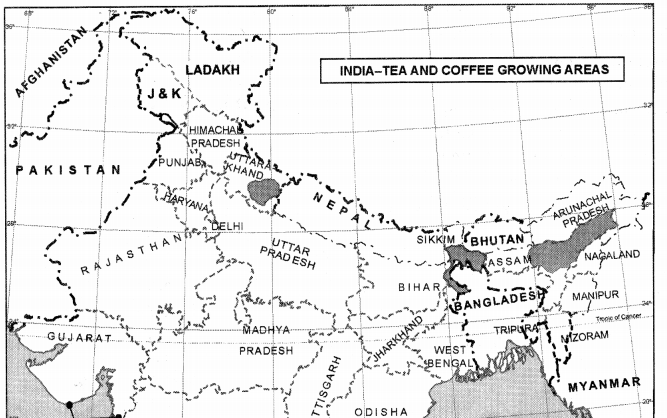

and Mangaluru. India earns a foreign exchange of about ₹ 1500 crores by this export.
Areas of Cultivation: Cool climate doesn’t encourage coffee cultivation in Northern India. Coffee is mostly grown in the hills and plateaus of Southern India in Shimoga, Kadoor, Hassan and Coorg districts (Nilgiris in Karnataka).
Question 6.
Analyse the geographical conditions required for the cultivation of Sugarcane. Describe the major producing areas of Sugarcane in India.
Answer:
Sugar is an important item in man’s food. Sugar is most widely liked and used in the world. This luxury item has a universal demand. The two main sources of sugar are sugarcane and sugar beet. About 5% sugar of the world is obtained from sugarcane. It is a commercial and industrial crop. Many products like Gur, Molasses, Paper, Wax and Fertilizers are prepared from sugarcane. India is considered the native place of sugarcane.
Conditions of Growth. Sugarcane is a plant of hot and wet tropical region.
(i) Temperature. High temperatures between 21°C and 27°C are required throughout the year. It is grown in a long sunny growing season. Frost and cloudiness are harmful for sugarcane.
(ii) Rainfall. A rainfall of 100 to 175 cms. is required. The harvesting period should be dry. Sugarcane is grown under irrigation in dry areas.
(iii) Soils. Sugarcane is grown well on deep, fertile soils which can retain moisture. Alluvial soils, volcanic soils and calcareous (Limestone) soils are best suited for the growth of sugarcane.
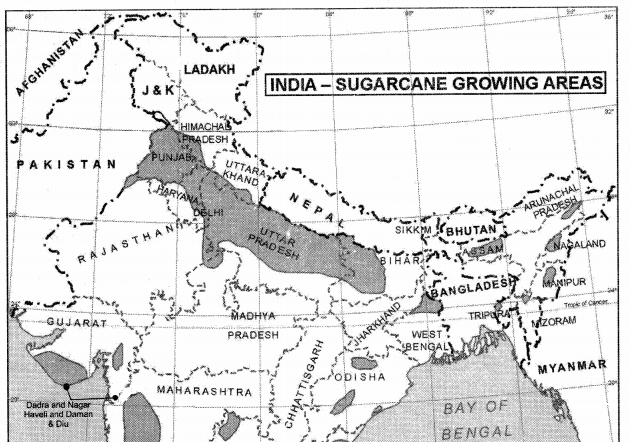
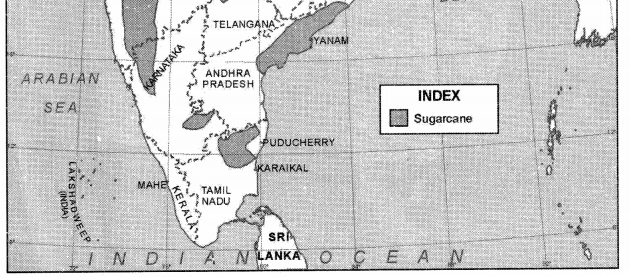
(iv) Cheap Labour. Large supply of cheap labour is required mainly at the harvest time.
(v) Land. Sugarcane is cultivated on level, well- drained low lands. Such areas provide easy transportation, irrigation and use of machines.
(vi) Sea-Breezes. In coastal areas, sea breezes are useful. These increase the sugar content.
(vii) Use of fertilisers. Soils are kept fertile with the use of fertilisers. It gives high yields.
Major Sugarcane Producing Areas:
India. India is the second largest and the oldest sugarcane producer (23%) in the world. India has the largest acreage (33%) under sugarcane in the world. But the yield is low. In India, favourable conditions are found in Southern India. This region with hot- wet climate gives better yield. About 60% of sugarcane is produced in Northern plain due to fertile soils. India produces about 2900 lakh metric ton sugarcane on an area of 33 lakh hectares.
Areas of Cultivation: The sugar belt of India extends from Gurdaspur (Punjab) to Darbhanga (Bihar), Uttar Pradesh with a production of 88 lakh tonnes, is the largest producer of sugarcane in India. It is grown in Doab, Terai and Gorakhpur region. Andhra Pradesh, Tamil Nadu, Maharashtra, Punjab and Bihar are other main producers of sugarcane.
Question 7.
Describe the conditions of growth, production and distribution of Millets in India.
Answer:
Millets
(i) Jowar. Jowar ranks third in area among foodgrains. Jowar can be grown in semi-arid and arid having rainfall under 45 cms. High temperature is necessary for its growth. It is generally grown on poor soils and in precarious rainfall zones. Jowar is both kharif and rabi crop. About 7.0 million hectares (5.3%) are devoted to this crop in India. Thanks to the hybrid seeds, its production increased.
Jowar is grown throughout the peninsular India but its notable concentration is on heavy or medium black soils and in regions with annual rainfall under 100 cms. Half (50.1%) of the jowar cropped area of the country is in Maharashtra. Karnataka (21.2%), Andhra Pradesh, Tamil Nadu and Madhya Pradesh are also major jowar producers.
(ii) Bajra. Bajra, an inferior millet crop, is grown on lighter soils and drier conditions than jowar, and therefore, does well on well-drained sandy, loamy soils and shallow black soils. Marusthali and Aravalli hills of Rajasthan, south-western Haryana, Chambal basin, south-western Uttar Pradesh; Kachchh, Kathiawar and northern Gujarat, and rain shadow area of Western Ghats of Maharashtra are important areas of bajra cultivation. It is also a rainfed kharif crop.
Bajra occupies 7.6 million hectares (about 5.0%) of cropped area of the country. Its production increased to 4.6 million tonnes. Rajasthan, is the largest bajra producing state in the country. Uttar Pradesh Maharashtra, Gujarat, and Haryana are other important producers of bajra.
(iii) Maize. Maize occupies 3.6 per cent of the cropped area of the country. Its production was 10.3 million tonnes. Both the area and production have increased rapidly. Use of yield raising hybrid strains, fertilisers, and irrigation helped in enhancing productivity. Production of maize has increased ten times between 1951 and 2001.
Maize is cultivated throughout the country. Karnataka ranks first in production, followed by Uttar Pradesh, Bihar and Andhra Pradesh. Madhya Pradesh, Rajasthan, Gujarat, and Himachal Pradesh are other producers.
(iv) Pulses. Pulses are the main source of protein in Indian diet. They are leguminous crops and enhance soil fertility by fixing. Nitrogen Pulses need less moisture and survive even in dry conditions. Tur (pigeonpea), urd (black gram), moong (green gram), and moth (brown gram) are major kharif crops and gram, peas, tur, masoor (lentil) and urd are rabi crops. Their production rose from 8.4 million tonnes to 11.4 million tonnes.
(v) Gram is the principal pulse crop in the country. The major gram growing areas are the Malwa plateau of Madhya Pradesh, north-eastern Rajasthan and southern Uttar Pradesh. Madhya Pradesh produces more than two-fifths (40.8%) of the total gram output in the country, Uttar Pradesh is next to it (19.6%).
Tur is another important pulse crop. Major tur producers are Maharashtra and Uttar Pradesh. The distribution of other pulse crops varies widely. Uttar Pradesh produced 2.2 million tonnes (20.3%) of pulses, and thus was the largest producer of pulses in the country. Madhya Pradesh (19.5%), and Maharashtra (15.3%) are other major pulse producing states.
Question 8.
What is Green Revolution ? What are its effects ?
Answer:
Green Revolution. Since the 1960s a new strategy has beer used for the intensive agricultural development in India. It has led to a rapid increase in the production of foodgrains in the country. A revolution has taken place in the agricultural methods and technology.
This revolution is known as Green Revolution. It includes the use of better quality seeds, high yielding varieties, chemical fertilisers, agricultural machinery, and to provide irrigation facilities. It has led to a complete modernisation of Indian agriculture.
This strategy was introduced to do away with food shortage and import of foodgrains. In 1965, the total production of foodgrains was 90 million tonnes. It became essential to increase the cropped area total production and yield per hectare. Wonderful results were achieved through Green Revolution. The total production of foodgrains in 2005-2006 has increased to above 230 million tonnes. In fact, Green Revolution has been a grain revolution.
It is clear from the following table :
| Year | Foodgrains production (Million tonnes) |
| 1966—67 | 74 |
| 1970—71 | 107 |
| 1977—78 | 110 |
| 1980—81 | 111 |
| 1984—35 | 150 |
| 1989—90 | 175 |
| 2005—06 | 230 |
| 2015—16 | 280 |
The adoption of Green Revolution has given a boost to agricultural development in many aspects such as— (i) The cropped area has increased due to multiple cropping.
(ii) The use of high yielding varieties of wheat and rice like Kalyan, Sonalika, Jaya, Ratna, etc. has led to increased yields per hectare. The yield of wheat rose from 13 quintal per hectare to 33 quintal per hectare in Punjab. In case of rice, a 45% increase in productivity was obtained in Andhra Pradesh.
(iii) The use of extensive irrigation increased the total production of foodgrains.
(iv) Use of chemical fertilisers led to higher yield per hectare.
(v) Massive programme of farm mechanisation, use of better quality seeds, and pesticides, use of agricultural implements has led to the success of Green Revolution.
Social effects: The standard of living of farmers has risen due to increase in per capita income. Tractor is a common asset in Punjab. Literacy has risen among the farmers. Recreation facilities are increasing due to Green Revolution.
It has not been possible to apply Green Revolution all over the country. Due to inadequate facilities of irrigation, fertilisers, lack of capital to purchase machinery, uneconomic size of land holdings, the sm all farmers could not take the advantage of Green Revolution.
Question 9.
‘Inspite of significant I development, Indian Agriculture suffers from some problems? Explain. (C.B.S.E. 2011, 2014)
Or
“Erratic monsoons and indebtness” are the major problems of Indians for agricultureSuggest and explain the measures to overcome these problems.
Or
Describe the major challenges of I agriculture in present india. (Sample Paper 2017-18)
Or
“Lack of Land reforms and degradation I of cultivable land are the major problems of Indian agriculture.” Substantiate the ; statement. (.Delhi 2019)
Or
“Erratic monsoon and low productivity are the major problems of Indian ; agriculture.” Substantiate the ; statement. (Delhi 2019)
Answer:
Problems of Indian Agriculture. Though Herculean efforts are being made for agricultural development, productivity of crops, however, is still low in comparison to the developed countries of the world. This situation is the result of the interplay of several factors. These are grouped into four classes: (i) environmental
(ii) economic
(iii) institutional, and
(iv) technological.
(i) Environmental Factors. The most serious problem is the erratic nature of the monsoon. Temperature remains high throughout the year. Therefore, crops can be grown all the year round if sufficient water could be supplied regularly. But it is not possible because major portion of the country receives rainfall during 3-4 months and rainfall amount and its seasonal and regional distribution are highly variable.
This situation affects the agricultural development. Major part of the country is sub-humid, sub-arid and arid as far as amount of rainfall is concerned. These regions suffer from frequent occurrences of droughts. Development of irrigation and water harvesting can raise productivity of these regions.
(ii) Economic factors. Investment in agriculture, use of inputs such as HYV, fertilisers etc. and transport facilities constitute economic factors. On account of lack of marketing facilities or non availability of loan on fair rate of interest, the cultivators are not able to invest the requisite resources in agriculture. This results in low productivity. In fact the pressure of population on land is continuously increasing. Consequently, per capita cropped land has declined from 0.444 hectare in 1921 to 0.296 hectare in 1961 and 0,219 hectare in 1991. The land holdings being small, the capacity to invest is also low.
(iii) Institutional factors. Increasing pressure of population is responsible for the sub-division and fragmentation of holdings. In 1961-62, about 52% of total holdings were marginal and small (below 2 ha. in size). In 1990-91, the percentage reached to 78% of the total holdings. Most of these holdings are also fragmented into a number of tiny plots. The uneconomic size of holdings is one of the major obstacles in the way of modernisation of agriculture. Land tenure system also does not favour large scale investment by tenants because of the insecurity of tenure.
(iv) Technological factors. Agricultural techniques are old and inefficient. Wooden plough and bullocks are still used by a majority of farmers. Mechanization is very limited. Use of fertilisers and HYV of seeds are also limited. Only one-third of the cropped area could be provided irrigation facilities. Its distribution is not in accordance with the deficit
Land Resources and Agriculture Important Extra Questions HOTS
Question 1.
‘Indian Agriculture is still dependent on rains.’ Explain.
Answer:
Indian agriculture is still dependent on rains. Out of the net cropped area of 142.82 million hectares (in 1996-97), only 55.14 million hectares (38.5%) are irrigated. Coarse cereals and millets, pulses, oilseeds and cotton are the principal rainfed crops. In areas getting more than 75 cm. annual rainfall, they are called rainfed crops. rainfall and its variability. These conditions keep the agricultural productivity and intensification of farming at low level.
Question 2.
Account for the highest intensity of crop in Punjab.
Answer:
Punjab state has the highest intensity of crop as 189 percent. Irrigation appears to be the principal determinant of the intensity of cropping. More than 94 percent of total cropped area is irrigated in Punjab, its intensity of cropping is also very high. Workability and fertility of soils and pressure of population also exert influence on the intensity of cropping. Modern high yielding crops helped a lot in intensification of cropping.
